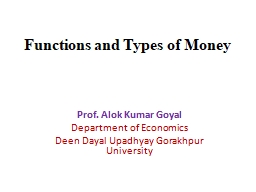

Prof Alok Kumar Goyal Department of Economics Deen Dayal Upadhyay Gorakhpur University Functions of Money 1 Primary Function 2 Secondary or Derived Function 3 Contingent Function ID: 1029355
Download Presentation The PPT/PDF document "Functions and Types of Money" is the property of its rightful owner. Permission is granted to download and print the materials on this web site for personal, non-commercial use only, and to display it on your personal computer provided you do not modify the materials and that you retain all copyright notices contained in the materials. By downloading content from our website, you accept the terms of this agreement.
1. Functions and Types of MoneyProf. Alok Kumar GoyalDepartment of EconomicsDeen Dayal Upadhyay Gorakhpur University
2. Functions of Money 1. Primary Function2. Secondary or Derived Function3. Contingent Function
3. Functions of Money 1. Primary Function: (a).Medium of Exchange (b). Measure of Value ( Unit of Account)2. Secondary Function: (a). Standard of Deferred Payment (b). Store of Value (c). Transfer of Payment
4. Functions of Money3. Contingent Function: (a).Basis of Credit (b). Distribution of Income (c). General form of Capital( Liquid Form) (d). Equalization of Marginal- Cardinal / Ordinal Approach
5. Types of Money 1. Commodity Money 2. Metallic Money 3.Paper Money 4. Inside Money 5. Outside Money 6.Legal Money 7. Option Money 8. Near Money ( Quasi Money) 9. Bitcoins ( Digital Money)- Virtual money --2009
6. Types of Money1. Commodity Money- skin of Animals, Courie shells, Animal etc.2. Metallic Money : Gold Standard & Silver Standard -( A special type of commodity money)- Full bodied or Standard Money ( Intrinsic value = Face value)3.Paper Money: Negligible Intrinsic value in comparison to Face Value 4. Inside Money- Creates liabilities ( Related to Banking & Non Banking Financial Institutions)- Demand Deposit & other deposits ( the money , which is an asset of depositor but coincides with liability of the banks & non banking Financial Institutions, is inside money.)5. Outside Money- No any liability ( Government issued money)- money that is not a liability for anyone inside the econmy . This type of money is backed by gold, assets denominated in foreign currency/foreign debt-foreign cash, stocks or bonds.6.Legal Money- Limited & Unlimited Legal Tender7. Option Money –Credit Money credit card, bills, cheques : Bank Money8. Near Money ( Quasi Money)- Its classification is based on degree of liquidity. Highly liquid assets which are not cash but can easily converted into cash– Savings A/c, Time Deposit, Bond with near redmptiondate, Govt treeasury bills , widely traded Foreign currencies ( US Dollar…)9. Bitcoins ( Digital Money)- Virtual money --2009
7. Types of Money1. Commodity Money- skin of Animals, Courie shells, Animal etc.2. Metallic Money : Gold Standard & Silver Standard -( A special type of commodity money)- Full bodied or Standard Money ( Intrinsic value = Face value)3.Paper Money: Negligible Intrinsic value in comparison to Face Value
8. Types Paper of Moneya). Representative paper money (Token Money)- 100% convertible value guaranteedb). Convertible paper currency- Converted into Standard money on demand ( Normally backed by Gold or Silver Reserves)c). Inconvertible paper money (Fiat money or legal Tender Money)- money issued by Government that is not convertible into gold or silver and has no intrinsic value. Money backed by order or authority of the Government. --Currency Notes & Token Coins (Made by cheap metal) d) Fiduciary money( Non legal Tender money) – Money that depends for its value on confidence that it is an accepted medium of exchange. Money backed up by trust b/w the Payer & Payee—Cheques
9. Types Paper of Money4. Inside Money- Creates liabilities ( Related to Banking & Non Banking Financial Institutions)- Demand Deposit & other deposits. ( Money , which is an asset of depositor but coincides with liability of the banks & non banking Financial Institutions, is inside money.)5. Outside Money- No any liability ( Government issued money)- Money that is not a liability for anyone inside the economy . This type of money is backed by gold, assets denominated in foreign currency/foreign debt-foreign cash, stocks or bonds.6.Legal Money- a)Limited Legal Tender Money--- In India,50 paise coins can be offered as legal tender for dues up to Rs 10 and smaller coins for dues up to Rs 1 .b) Unlimited Legal Tender Money- Currency Notes can be offered as payment for dues of any size.
10. Types Paper of Money7. Option Money –Credit Money credit card, bills, cheques : Bank Money8. Near Money ( Quasi Money)- Its classification is based on degree of liquidity. Highly liquid assets which are not cash but can easily converted into cash– Savings A/c, Time Deposit, Bond with near redemption date, Govt treeasury bills , widely traded Foreign currencies ( US Dollar…)9. Bitcoin(Digital Money)- Virtual money or Cryptocurrency
11. Bitcoin ( Digital Money)- Virtual MoneyBitcoin is a cryptocurrency invented in 2008 by an unknown person or group of people using the name Satoshi Nakamoto and started in 2009 when its implementation was released as open-source software. Bitcoin is a digital currency created in January 2009 following the housing market crash. It follows the ideas set out in a whitepaper by the mysterious and pseudonymous Satoshi Nakamoto. The identity of the person or persons who created the technology is still a mystery. Bitcoin offers the promise of lower transaction fees than traditional online payment mechanisms and is operated by a decentralized authority, unlike government-issued currencies. There are no physical bitcoins, only balances kept on a public ledger that everyone has transparent access to, that – along with all Bitcoin transactions – is verified by a massive amount of computing power. Bitcoins are not issued or backed by any banks or governments, nor are individual bitcoins valuable as a commodity. Despite it not being legal tender, Bitcoin charts high on popularity, and has triggered the launch of hundreds of other virtual currencies collectively referred to as Altcoins.
12. Thank You